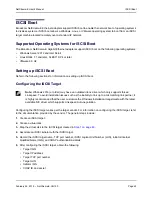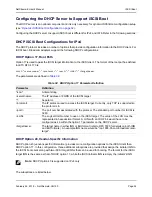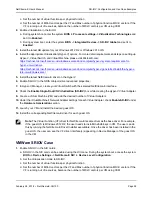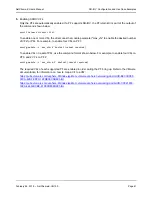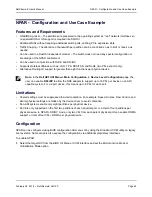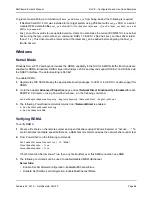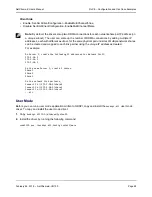
SR-IOV: Configuration and Use Case Examples
NetXtreme-E User’s Manual
February 26, 2018 • NetXtreme-E-UG100
Page 59
c. Set the number of virtual functions per physical function.
d. Set the number of MSI-X vectors per the VF and Max number of physical function MSI-X vectors. If the
VF is running out of resources, balance the number of MSI-X vectors per VM using CCM.
2.
Enable virtualization in the BIOS:
a. During system boot, enter the system
BIOS -> Processor settings -> Virtualization Technologies
and
set it to
Enabled
.
b. During system boot, enter the system
BIOS -> Integrated Devices -> SR-IOV Global
and set it to
Enabled
.
3.
Install the latest KB update for your Windows 2012 R2 or Windows 2016 OS.
4.
Install the appropriate Virtualization (Hyper-V) options. For more detail requirements and steps on setting up
Hyper-V, Virtual Switch, and Virtual Machine, please visit Microsoft.com:
5.
Install the latest NetXtreme-E driver on the Hyper-V.
6.
Enable SR-IOV in the NDIS miniport driver advanced properties.
7.
In Hyper-V Manager, create your Virtual Switch with the selected NetXtreme-E interface.
8.
Check the
Enable Single-Root I/O Virtualization (SR-IOV)
box while creating the Hyper-V Virtual Adapter.
9.
Create a Virtual Machine (VM) and add the desired number of Virtual Adapters
10.
Under the Virtual Machine's Network Adapter settings for each Virtual Adapter, check
Enable SR-IOV
under
the
Hardware Acceleration
section.
11.
Launch your VM and install the desired guest OS.
12.
Install the corresponding NetXtreme-E driver for each guest OS.
VMWare SRIOV Case
1.
Enable SR-IOV in the NIC cards:
a. SR-IOV in the NIC card can be enabled using the HII menu. During the system boot, access the system
BIOS -> Device Settings -> NetXtreme-E NIC -> Device Level Configuration
.
b. Set the Virtualization mode to SR-IOV.
c. Set the number of virtual functions per physical function.
d. Set the number of MSI-X vectors per the VF and Max number of physical function MSI-X vectors. If the
VF is running out of resources, balance the number of MSI-X vectors per VM using CCM.
Note:
The Virtual Function (VF) driver for NetXtreme-E is same driver as the base driver. For example,
if the guest OS is Windows 2012 R2, the user needs to install Bnxtnd64.sys in VM. The user can do
this by running the NetXtreme-E Driver Installer executable. Once the driver has been installed in the
guest OS, the user can see the VF driver interface(s) appearing in Device Manager of the guest OS
in the VM.





